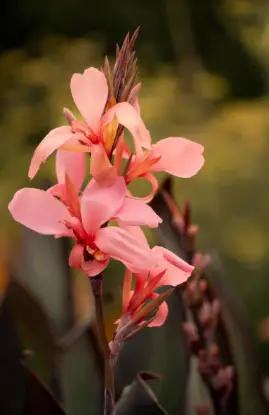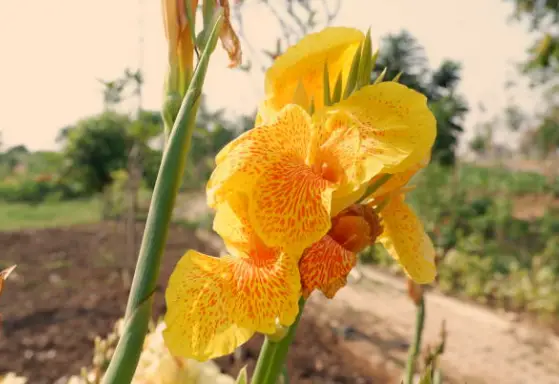The canna lily is the perfect plant to use if you want to give your landscape some vivid texture and dramatic effects. appreciated for their stunning flower displays in tones of red, orange, yellow, pink, and sometimes near-black, these towering tropicals are also appreciated for their thick, banana-like foliage. However, the remarkable height of canna lilies is one of its most remarkable characteristics. Let us explore the magnificent altitudes to which these plants can rise, as well as the means by which we can guarantee that they do so.
The Basics Height of Canna Lily Plant
Canna lilies are typically categorized as perennials that grow upright and create clumps, with thick stems that resemble little trees. When fully grown, they can reach heights of 2 to 8 feet, depending on the variety. The tallest cultivars reach a maximum height of approximately 2-3 feet, whilst true skyscrapers reach an astounding height of 6-8 feet.

Some of the tallest canna lily varieties include:
– ‘Tropicana Black’ – Up to 8 feet
– ‘Wyoming’ – 6-8 feet
– ‘Cleopatra’ – 6-7 feet
– ‘Durban’ – 5-6 feet
On the shorter side (but no less impressive) you’ll find varieties like:
– ‘Lucifer’ – 2-3 feet
– ‘Edness’ – 3 feet
– ‘Intrigue’ – 2.5-3.5 feet
The wide leaves and vivid blooms of even the more petite types are very striking. However, the sky-high variety are where it is at if you really want to create a rich tropical vibe together with a visually arresting vertical aspect.
Factors Influencing Height
While a canna cultivar’s maximum height potential is mostly determined by genetics, there are a number of environmental and cultural elements that can also influence how tall the plants end up growing:
Light Exposure
Canna lilies love full sun, with at least 6-8 hours of direct sunlight each day. Insufficient light will cause them to become leggy and stretched out as they desperately try to increase their exposure. For maximum height, give them a nice sunny spot.
Soil Quality
Like many large, vigorous growers, cannas prefer nutrient-rich soil. A fertile loam amended with compost or other organic matter allows them to achieve their full height and lush foliage potential. Poor or compacted soil will stunt their growth.
Moisture Levels
Maintaining a steady moisture level is essential for promoting canna vertical development. In between waterings, let the soil dry out a little, but do not allow it get completely dry. Shrunken, little plants are the result of droughts and insufficient hydration.
Division/Transplanting
Canna lilies can remain in the same spot for years, but overcrowding stunts growth. Dividing and transplanting overgrown clumps every few years allows the rhizomes to spread out, with more room for the stems to elongate.
Temperature
As tropical plants, cannas thrive in warm to hot conditions. Consistently cool temperatures prevent them from achieving their maximum height. The warmer it gets, the taller they’ll grow.
Fertilization
Cannas are heavy feeders that benefit from frequent fertilization, just like any other plant that develops so quickly and large. Throughout the growing season, towering stems and luxuriant foliage are supported with a balanced liquid fertilizer sprayed every 2-4 weeks.
Staking
While their sturdy stems usually remain upright, the tallest canna varieties may need some support once they exceed 6 feet. Inserting a tomato cage or bamboo stake provides added stability and prevents stem breakage.
Maximizing Height in Your Garden

Canna Lily Plant Height
Ready to see your cannas reach dizzying new heights? Here are some tips to encourage vertical growth:
1) Start with varieties known for their tall stature like ‘Tropicana Black,’ ‘Wyoming,’ or ‘Cleopatra.’
2) Amend the soil by mixing in generous amounts of compost, aged manure, or other organic matter before planting. This provides nutrient-rich conditions from the start.
3) Plant in a spot with full, direct sun exposure – at least 6 hours per day.
4) Maintain consistent soil moisture through regular watering. Cannas are thirsty plants!
5) Feed every 2-4 weeks during the growing season with a balanced liquid fertilizer.
6) In late spring, divide any overcrowded clumps and replant with plenty of spacing to allow uninhibited growth.
7) Provide support with tomato cages or stakes once plants reach 5-6 feet tall to prevent stems from falling over.
You will soon be able to see the magnificent sight of your cannas reaching new heights in your garden with the correct growing conditions and care! With its enormous foliage and vibrant blooms, these towering tropicals provide a striking impression.
So don’t be afraid to let your canna lilies shoot for the stars. With some simple maintenance, you can create your own personal jungle of sky-scraping plants. Whether you prefer the imposing giants nearing 8 feet tall, or appreciate a more modest 3-4 foot specimen, there’s a canna to suit any garden and vertical ambition. Get ready to look up in awe as these stunners stretch their way toward the sun!




